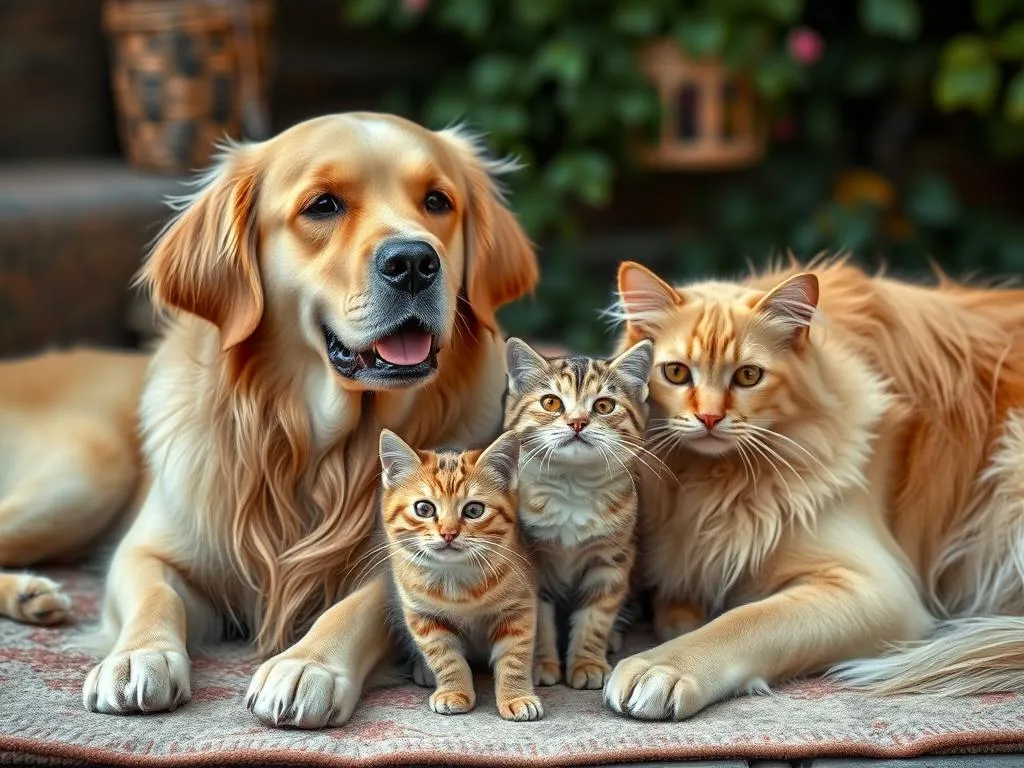
When considering the dynamics of a multi-pet household, one of the most frequently asked questions is, are Golden Retrievers good with cats? The answer is often more nuanced than a simple yes or no, as it depends on various factors, including individual personalities and early socialization experiences. Understanding the behaviors of both Golden Retrievers and cats is crucial to fostering a harmonious living environment.
Understanding Dog Breeds
Definition of Dog Breeds
Dog breeds are specific groups of domestic dogs that have been selectively bred for particular traits and characteristics, such as size, coat type, temperament, and purpose. These breeds are categorized based on their physical attributes and behavioral tendencies, which can significantly influence how they interact with other animals, including cats. For instance, some breeds may be more predisposed to chase smaller animals, while others might be more gentle and accommodating.
Overview of Popular Dog Breeds
While there are numerous dog breeds, a few stand out as particularly popular, such as Labradors, Poodles, Beagles, and of course, Golden Retrievers. Each breed comes with its own set of characteristics that can affect their behavior. For example, Labrador Retrievers are known for their friendly disposition, while Beagles might have a stronger prey drive. Understanding these differences is essential for anyone considering introducing a dog into a home with cats.
Golden Retrievers: An Overview
History and Origin
Golden Retrievers originated in Scotland in the late 19th century. They were developed to assist hunters in retrieving game from both water and land, making their temperament ideal for family companionship and hunting alike. Their friendly nature and eagerness to please were key traits that made them popular as family pets.
Temperament Traits
Golden Retrievers are renowned for their friendly, social, and gentle nature. They are highly intelligent and trainable, often excelling in obedience and agility training. Their energy levels are moderate to high, making them playful companions who enjoy engaging in various activities. This combination of traits makes them generally well-suited for families and multi-pet households.
Cats and Their Behavior
Understanding Cat Behavior
Cats have unique behavioral traits that can differ significantly from those of dogs. They are generally more independent and territorial, often valuing their personal space. Understanding a cat’s instincts, such as their need for territory and their hunting behaviors, is crucial when introducing them to a new dog. Cats may perceive a dog as a potential threat, especially if the dog displays high energy or chasing tendencies.
Common Cat Breeds
Just as with dogs, there are several popular cat breeds, including Siamese, Persians, and Maine Coons. These breeds exhibit different behaviors; for example, Siamese cats are known for their vocal nature and social tendencies, while Persians are typically more laid-back. Recognizing these differences can help in anticipating how a cat might react to a new dog, such as a Golden Retriever.
Are Golden Retrievers Good with Cats?
General Compatibility
In general, Golden Retrievers are considered good with cats. Their friendly and social nature allows them to coexist peacefully with felines in many cases. Studies and anecdotal evidence suggest that dogs and cats can form strong bonds, particularly when the dog is well-socialized and trained to respect the cat’s space.
Factors Influencing Compatibility
Socialization
One of the most critical factors in determining whether Golden Retrievers are good with cats is socialization. Early exposure to cats can help a Golden Retriever learn to behave appropriately around them. Introducing a Golden Retriever to a cat in a controlled and positive manner is essential. Gradual introductions can ease tensions and foster a sense of safety for both pets.
Individual Personality
While breed tendencies provide a general framework, it is essential to remember that individual temperament plays a significant role. Some Golden Retrievers may have a stronger prey drive or be more excitable than others. Observing and understanding the individual personalities of both the dog and the cat can provide insight into how they might get along.
Age and Training
The ages of both pets can influence their interactions. A younger Golden Retriever may be more energetic and playful, which could overwhelm an older, more reserved cat. Conversely, older dogs may be more adaptable and calm. Training is also crucial; teaching a Golden Retriever commands such as “leave it” or “gentle” can help manage their behavior around a cat.
Tips for Introducing Golden Retrievers to Cats
Preparing the Environment
Creating a safe environment for both pets is essential. This involves setting up separate spaces where each animal can retreat to if they feel overwhelmed. High perches, cat trees, or gated areas can provide cats with safe zones. Additionally, removing any potential hazards, such as small objects that could be swallowed or items that could be knocked over during play, is advisable.
Gradual Introduction Techniques
Introducing a Golden Retriever to a cat should be done gradually to ensure a positive experience for both animals. The following steps can help:
-
Scent Introduction: Before any face-to-face meetings, allow the dog and cat to become familiar with each other’s scents. Swap bedding or use a cloth to transfer scents between the two.
-
Controlled Meetings: Use a leash to control the Golden Retriever during initial introductions. Keep the cat in a separate room and allow them to observe the dog from a distance.
-
Short Interactions: Gradually shorten the distance between them during supervised meetings. Keep these sessions brief and positive, rewarding both pets with treats for calm behavior.
-
Supervision: Always supervise interactions until you are confident they can coexist safely. Look for signs of stress or aggression in either pet, and intervene if necessary.
Monitoring Interactions
During the initial interactions, it’s crucial to observe both pets closely. Signs of stress in dogs may include excessive barking, panting, or pacing, while cats may flatten their ears, hiss, or try to escape. Recognizing these signs early can prevent negative encounters and help maintain a peaceful environment.
Potential Challenges
Aggression and Playfulness
One concern when introducing Golden Retrievers to cats is the potential for aggression or rough play. Golden Retrievers are playful by nature, but their size and energy can be intimidating to smaller cats. It’s essential to manage these interactions carefully. Teaching the dog commands like “gentle” can help mitigate rough behavior, while providing the cat with escape routes and safe spaces can reduce stress.
Territory Issues
Territorial behavior is common in cats, and introducing a new dog can challenge this aspect of their nature. Cats often view their home as their territory and may become defensive when a new dog enters. To minimize territorial disputes, it can be helpful to ensure that each pet has its own designated areas, including feeding stations and resting spots.
Success Stories
Case Studies
Many pet owners have successfully integrated Golden Retrievers with cats, leading to harmonious households. For instance, one family adopted a Golden Retriever and had a resident cat. After following gradual introduction techniques, they found that the two animals not only cohabitated peacefully but also developed a close bond. They often played together, with the dog being gentle and the cat enjoying the companionship.
Testimonials from Pet Owners
Pet owners frequently share their success stories of Golden Retrievers living amicably with cats. One owner, Jane, noted, “My Golden Retriever, Max, was raised with my cat, Bella. They are the best of friends! Max knows to be gentle, and Bella often initiates playtime. It’s heartwarming to see them together.” Such anecdotes highlight the potential for positive relationships between these two beloved pets.
Conclusion
In summary, Golden Retrievers can be good with cats, provided that proper introductions and socialization techniques are employed. Understanding the behaviors and traits of both species is crucial for fostering a peaceful coexistence. While individual temperament and training play significant roles, many success stories prove that with patience and care, Golden Retrievers and cats can form loving relationships in multi-pet households. Emphasizing responsible pet ownership and understanding the needs of both dogs and cats can lead to a harmonious home environment.






